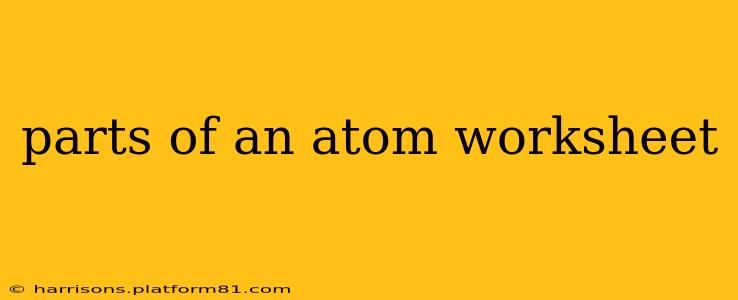This worksheet delves into the fascinating world of atoms, the fundamental building blocks of matter. We'll explore the subatomic particles that make up atoms and their properties, going beyond a basic understanding to grasp the intricacies of atomic structure. This is perfect for students looking to solidify their knowledge of atomic theory and prepare for assessments.
What are the main parts of an atom?
Atoms are composed of three primary subatomic particles:
- Protons: Positively charged particles located in the atom's nucleus (center). The number of protons determines the element's atomic number and its identity.
- Neutrons: Neutrally charged particles also residing in the atom's nucleus. They contribute to the atom's mass but not its charge. The number of neutrons can vary within the same element, leading to isotopes.
- Electrons: Negatively charged particles that orbit the nucleus in electron shells or energy levels. They are significantly smaller and lighter than protons and neutrons. The number of electrons typically equals the number of protons in a neutral atom.
Understanding Atomic Number and Mass Number
- Atomic Number (Z): This represents the number of protons in an atom's nucleus. It uniquely identifies the element. For example, hydrogen (H) has an atomic number of 1, meaning it has one proton.
- Mass Number (A): This is the total number of protons and neutrons in an atom's nucleus. It represents the atom's mass. To calculate it, add the number of protons and neutrons.
How do electrons arrange themselves around the nucleus?
Electrons occupy specific energy levels or shells around the nucleus. These shells have different capacities for electrons:
- Shell 1 (closest to the nucleus): Holds a maximum of 2 electrons.
- Shell 2: Holds a maximum of 8 electrons.
- Shell 3: Holds a maximum of 18 electrons.
And so on... The arrangement of electrons in these shells determines an atom's chemical properties and how it interacts with other atoms. This electron configuration is crucial in understanding chemical bonding.
What are isotopes?
Isotopes are atoms of the same element (same number of protons) but with different numbers of neutrons. This means they have the same atomic number but different mass numbers. For example, carbon-12 (⁶C) and carbon-14 (¹⁴C) are isotopes of carbon. They both have 6 protons, but carbon-12 has 6 neutrons, while carbon-14 has 8 neutrons. Some isotopes are radioactive, meaning they decay over time, emitting radiation.
What are ions?
Ions are atoms that have gained or lost electrons, resulting in a net positive or negative charge.
- Cations: Positively charged ions formed when an atom loses electrons.
- Anions: Negatively charged ions formed when an atom gains electrons.
The formation of ions is critical in chemical reactions and the formation of ionic compounds.
Practice Questions:
- What are the three main subatomic particles? Describe their charge and location within an atom.
- What is the difference between atomic number and mass number? How are they calculated?
- Explain the concept of isotopes using an example. What makes isotopes of the same element different?
- What are ions? How are cations and anions formed? Give examples.
- Draw a simple diagram of an atom, labeling its components and indicating their charges.
This worksheet provides a foundation for understanding atomic structure. Further exploration into electron configurations, quantum mechanics, and nuclear chemistry will build upon this knowledge. Remember to consult your textbook or other resources for additional information and clarification.
